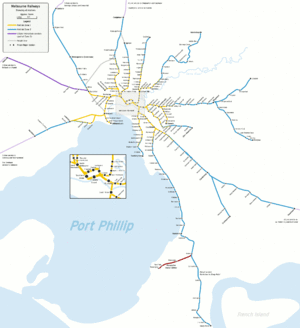Melton railway line
| Melton railway line, Melbourne | |
|---|---|
 | |
| Line details | |
| Tracks | Double track to Deer Park station, single track with loops beyond |
| Used by | V/Line, freight |
| Service pattern | Peak hour local trains to Melton and Bacchus Marsh, off peak Ballarat services |
| Connections | Sunbury and Ballarat lines |
| Railways in Melbourne | |
The Melton line is a greater-metropolitan subsection of the Ballarat line in Victoria, Australia. It is incorporated into Melbourne's suburban railway network and is in Metlink ticketing Zone 2. The line branches from the Sunbury line at Sunshine, with all services departing from Southern Cross Station in the CBD.
The line consists of dual track until just west of Deer Park station where it becomes a single bi-directional track. There is another stretch of double track close to Rockbank station to facilitate the passing of trains. Despite the Regional Fast Rail project, there are no plans to duplicate this line.
There are a variety of trains on the line including VLocity & Sprinter type DMUs, as well as older locomotive-hauled carriages. All trains continue onto Bacchus Marsh, Ballarat or Ararat.

Line guide
Bold stations are termini, where some train services terminate; italic stations are staffed. Metcards are not valid past Melton station.
Branches from the Sunbury line at Sunshine.
Legend
| |||||||||||||||||||||||||||||||||||||||||||||||||||||||||||||||||||||||||||||||||||||
Future Upgrade
The Victorian State Government, as part of its Victorian Transport Plan (released in 2008), announced the progressive upgrade of the Melton Line to support future urban development in the corridor. This will begin with the construction of a new station at Caroline Springs (Ravenhall) beginning in 2010. Another additional station is planned at Toolern, between the existing Melton and Rockbank Stations, as part of the Toolern urban development, however no date for this has yet been determined. It is expected that the number of services will double following the electrification of the Sunbury Line (and re-allocation of the diesel rolling stock to Melton) in 2012. The line will also be progressively duplicated to support urban development and improved service frequency, before ultimate electrification.